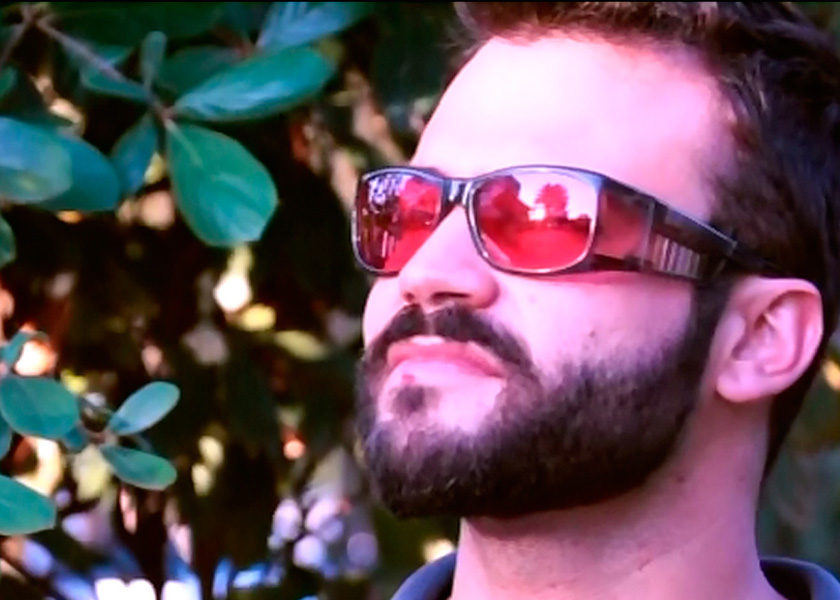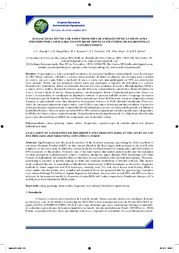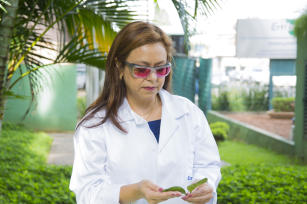Special glasses identify greening symptoms in citrus leaves
Special glasses identify greening symptoms in citrus leaves
A pair of eyeglasses with lenses coated with a special filter is the newest invention to detect the symptoms of huanglongbing (HLB), also known as greening, during the visual inspection of citrus orchards. The novelty, which is already available in the market, allows the user to see the main trace of the disease, known as leaf mottling or yellowing, as it intensifies the contrast between the green and yellow colors, characteristics of the pest.
The glasses that assist the visual inspection of greening in citrus crops will facilitate the work of inspectors, reduce the rate of errors in the identification of the disease, and provide visual protection to the user. Their inventors believe that the technology could be used beyond Brazil, by inspectors in other citrus producing countries, such as the United States, China, Mexico, Spain and India.
Although many techniques are being developed to improve the identification of infected plants, so far devices that can be applied to visual inspection for greening in the fields are unknown.
When the traditional method is followed, greening, the worst citrus disease in recent times, can be identified through visual inspection by trained professionals, but with high failure rates. It is believed that half of symptomatic plants remain in the fields due to inspection errors, which allows the disease to spread to healthy trees.
Developed by Embrapa Instrumentation and the Federal University of São Carlos (UFSCar), the Citrus Greening Inspection Glasses will be introduced at the 24th International Trade Fair of Agricultural Technology in Action (Agrishow), which takes place from May 1 to May 5, in Ribeirão Preto, São Paulo.
The patented technology is made available by Fhocus Optical Solutions - a company that is licensed to manufacture and trade the eyeglasses, headquartered in São Carlos, SP, and with a branch in São Paulo city -, and can be acquired through the company's page or telephone.
According to Fhocus' director of Marketing, Clédio Romero Rodriguez, the unit cost of the glasses is estimated at R$ 200.00, but it could be reduced in light of the amounts that are ordered. Above 100 items, the company calculates that the price can fall to approximately R$ 170.00 per unit. “Our market expectation is quite optimistic and we have the production capacity to swiftly absorb 500 pieces per month”, he asserts.
Rodrigues recalls that the technology is being produced in accordance with the strict requirements of the American National Standards Institute (ANSI), and he believes that the product must be consolidated as an innovative work tool to help reduce contamination in orange groves.
Color Theory
The study resulted from the student Luiz Otávio dos Santos Arantes' Master's dissertation at UFSCar's Department of Production Engineering, concluded in 2013, with the support of professor Nilton Luiz Menegon and of Embrapa Instrumentation's researcher Débora Milori. Arantes was also supported by the São Paulo State Research Support Foundation (Fapesp, from the acronym in Portuguese) with a little over R$ 28,000 in funds.
Débora reports that the initial idea was to develop ultraviolet protection systems, upon a Brazilian orange juice industry's request. However, discussions brought about a proposal to evaluate the possibility of adding an additional filter to eyeglasses that would make greening symptoms stand out, and thus facilitate visual inspection.
The study then moved on based on the so-called Color Theory, according to which, in order to absorb a given coloration, a body must reflect the color that is complementary to it. The survey took about three years, with the study of filters, field trials, and laboratory trials, before getting to the market.
The researcher explains that the light filter mostly attenuates the color green, leading to a higher perception of contrast by the human eye, a physiological factor that occurs due to the human retina's hypersensitivity to green. Thus, it is possible that peripheral tones that would not be normally perceived are then identified. This entails that field inspectors will be able to more easily identify small changes from green to yellow due to the disease.
If the leaf is healthy, that is, if it is in the right shade of green, the filter mitigates the transmission of the color, and one views it in a darker color. However, if the leaf presents any color alterations, the device allows this change to be transmitted through the light filter, and it is shown to be lighter.
But the researcher Débora Milori comments that, even with the use of the glasses during the visual inspection on citrus greening, the suitable detection of the symptoms relies on inspectors' experience, as leaf mottling can occur due to many other factors, such as zinc deficit or a broken branch hindering sap flow.
Benefits of the technology
Milori informs additional advantages of the invention: the device blocks ultraviolet rays, providing the user with protection against sunlight and visual comfort during the activity.
The technology is rather flexible and can even be applied in different materials and formats, i.e. jointly with other personal protection equipment (PPE) such as helmets, mufflers, ear protectors and respirator masks. Fhocus' Marketing director says that, should the user require corrective lenses, the greening detector glasses can be adapted the user according to their doctor's prescription.
In his research, Luiz Otávio dos Santos Arantes recorded that the workers stated that the glasses promote visual comfort and lower the effort to identify the disease, on top of the increase in the amount of detected plants. "Everyone liked it and asked to keep using the equipment as it makes their job much easier", say the former Master's degree candidate who believes that the glasses can reduce the incidence of time way on leave.
His advisor at UFSCar, Nilton Menegon, says that the invention was inspired in similar applications to identify diseases in plantations and even for military use. He declared that the work was based on such technologies to develop a specific filter for greening. "Our work was to identify a frequency that would allow some wave lengths to pass and not others. The difference between the light that reaches the glasses and the one that passes through them is what allows the operator's improved perceptive capacity", he explains.
|
Greening is a disease that originated in China and appeared over a hundred years ago. It is caused by four Candidatus-type bacteria − Liberibacter spp., Liberibacter africanus, Liberibacter asiaticus and Liberibacter americanus. In Brazil, the disease was first identified in March 2004, in the city of Araraquara, São Paulo, but is currently present in all the citrus regions of the state and in orchards in Minas Gerais and Paraná. According to a report by the São Paulo Coordination of Agricultural Defense, the state eradicated 5.7 million plants with greening in the first half of 2014 alone. The symptoms appear in the plant leaves and the disease can be characterized in the branches, which lose part of their green coloration and become partially yellow and green, without a clear delimitation between the two colors. This symptom, which is called “mottling”, is the most characteristic trait of greening-infected plants, as it has been observed in every place to which the disease has spread so far. The plant leaves can sprout with a reduced size and present chlorosis (yellowing), resembling a symptom of iron or zinc defficiency. Chlorosis caused by greening, however, is asymmetrically distributed in the leaf. Symptomatic fruits are generally small and deformed, can present fully or partially green basal portion of the rind, as well as albedo − the white part of the rind − thickening and aborted seeds. In accordance with the Ministry of Agriculture, Livestock, and Food Supply (MAPA)'s regulations, growers have to inspect and eliminate sick plants. The citrus grower who does not eradicate sick plants can be fined with up to 3,500 UFESPs (São Paulo State Fiscal Unit). In 2013, each UFESP cost R$ 19.37. |
Translation: Mariana Medeiros.
Joana Silva (MTb 19.554/SP)
Embrapa Instrumentation
instrumentacao.imprensa@embrapa.br
Phone number: +55 16 2107 2901
Tatiane Furukawa Liberato (MTb 60.276/SP)
UFSCar Innovation Agency
tatiane.liberato@fai.ufscar.br
Phone number: +55 16 3351-9085
Further information on the topic
Citizen Attention Service (SAC)
www.embrapa.br/contact-us/sac/




